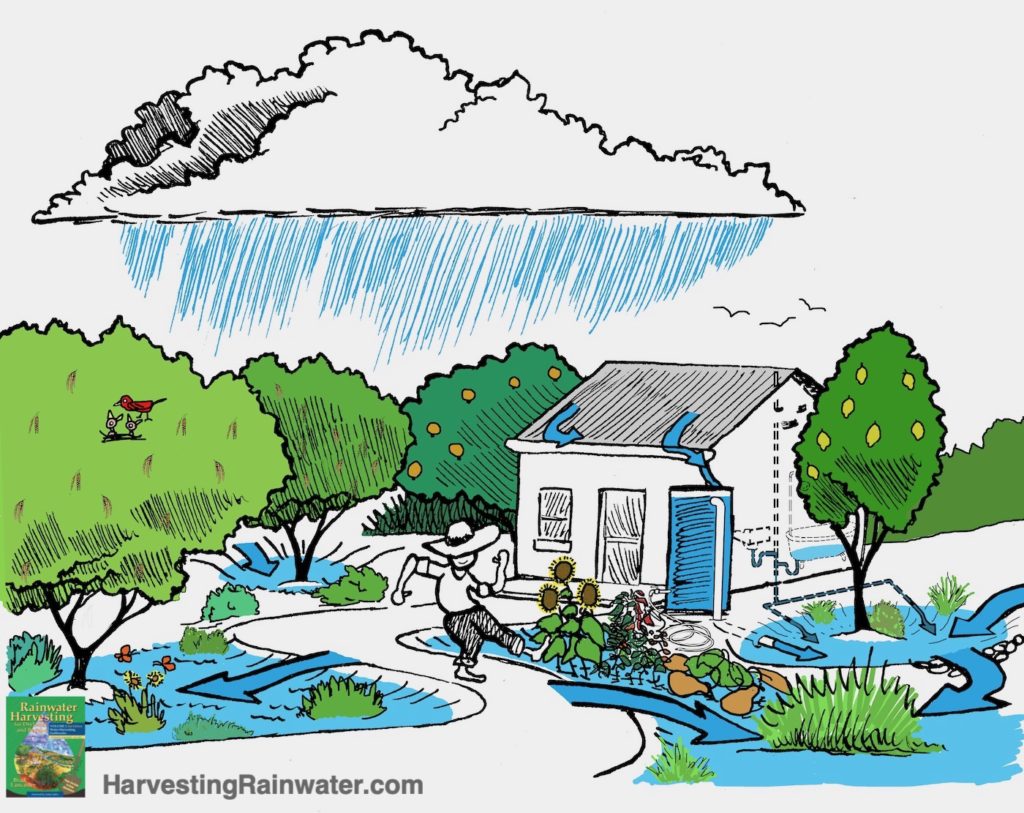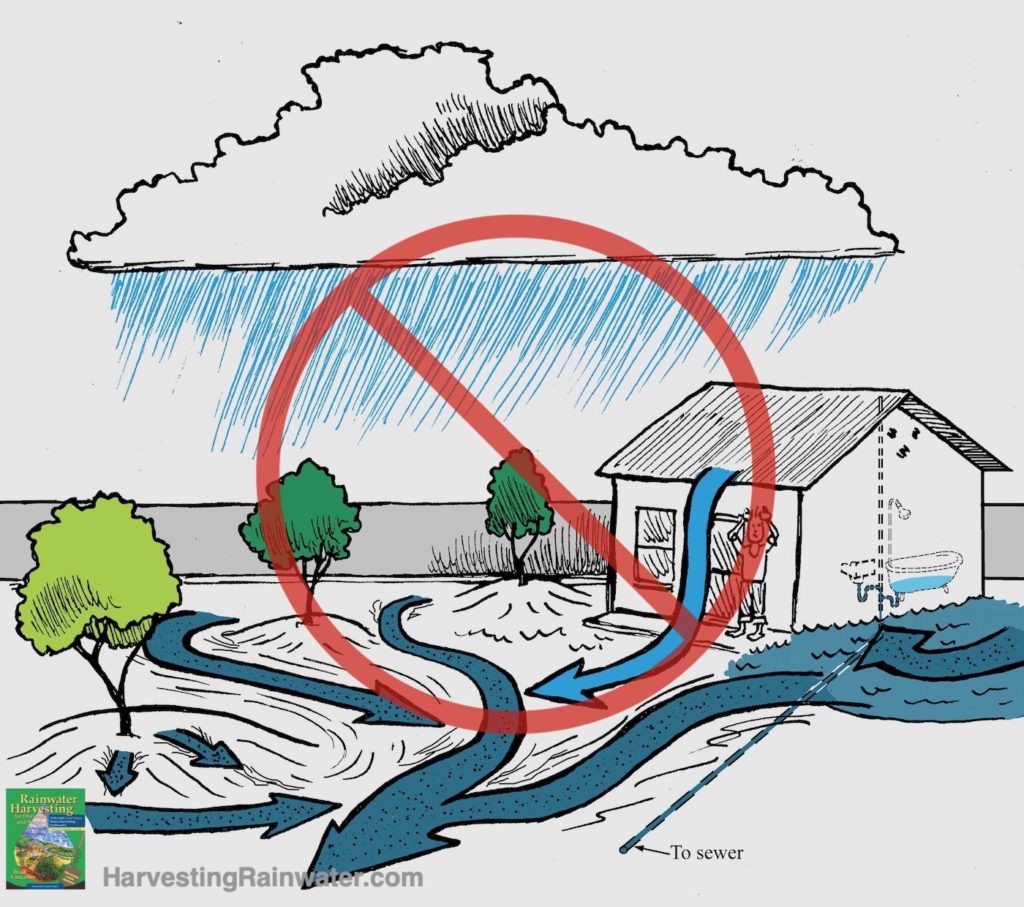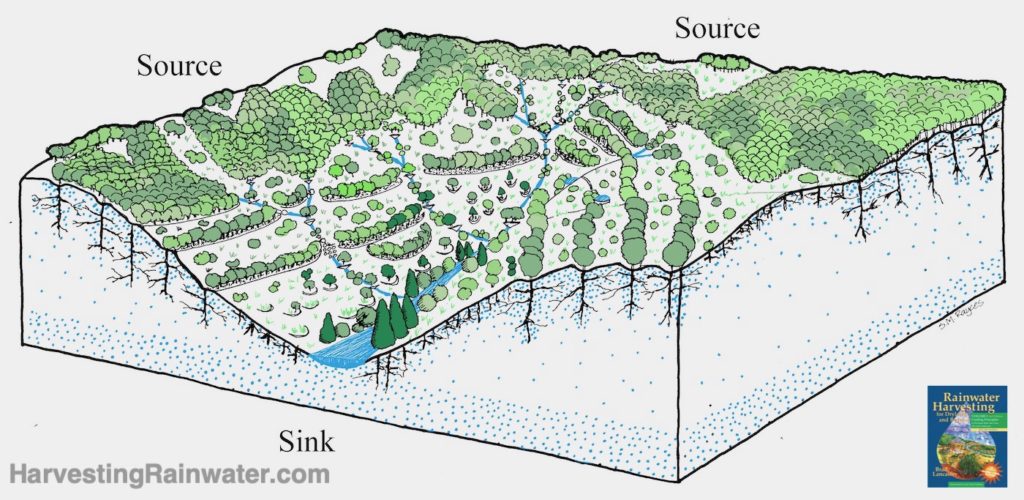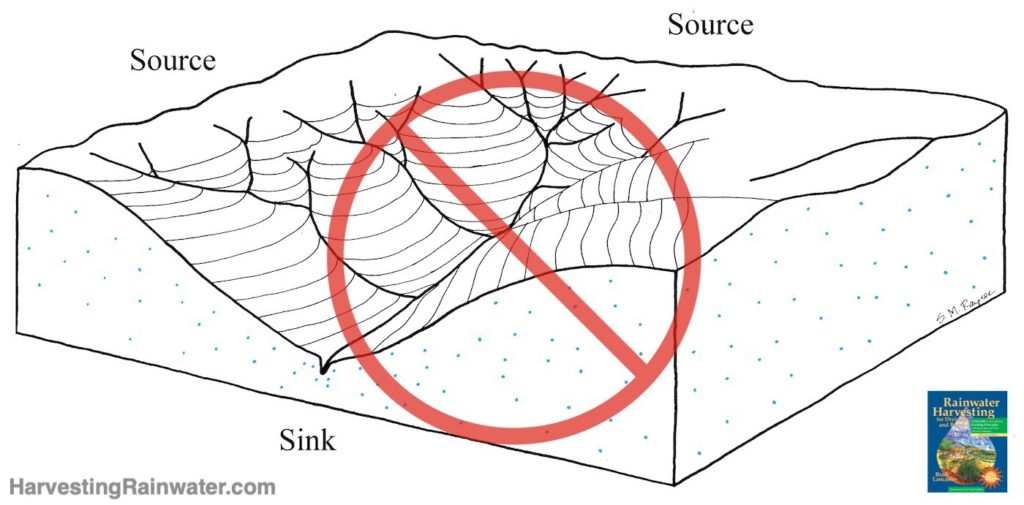Water Harvesting
Water harvesting is the practice of planting/infiltrating or tanking, utilizing, and cycling of free on-site waters (rain, stormwater runoff (such as street runoff), greywater, dark greywater, condensate, snow, & fog), in a way that maintains or improves their quality, maximizes their availability and accessibility over time (even in droughts), reduces on-site and downstream flooding in wet times, and helps grow more life and fertility—so that water, soil, and living conditions improve on both the site where we live; and throughout the larger community and our shared watershed.

This site passively hydrates itself by harvesting, infiltrating, and bioremediating rainwater, runoff, and greywater on site, which reduces downslope flooding and overall water consumption, while improving water quality.
The need to pump in water is greatly reduced or eliminated.
Leaf drop and other organic matter is also harvested and cycled back into the soil and plants, further increasing fertility and water-holding capacity.
This leads to an enhancement of resources and a bun dance of celebration due to the resulting abundance.
Reproduced with permission from Rainwater Harvesting for Drylands and Beyond, Volume 2, 2nd Edition. Illustration by Joe Marshall.
Water harvesting is NOT the rapid draining of water, soil, nutrients, and potential off site. Nor is it the importation of pumped-in or trucked-in waters extracted from elsewhere and others.

This site rapidly dehydrates itself by erosively draining rainwater and runoff away, which floods downslope areas and contaminates surface water with sediment.
Household greywater is lost to the sewer.
Costly municipal or well water is pumped in to replace the free water that was drained away.
Blue arrow denotes cleaner runoff water flow. Dirty blue arrows denote dirtier, sediment-laden water runoff flow. Leaf drop and other organic matter is also drained away, further depleting fertility and water-holding capacity.
This leads to a depletion of resources and feeling scared in the city due to the resulting scarcity.
Reproduced with permission from Rainwater Harvesting for Drylands and Beyond, Volume 2, 2nd Edition. Illustration by Joe Marshall.
Water harvesting is inspired by, and strives to, collaborate with the planet’s natural hydrologic systems. Less than 3% of this planet’s water is fresh (not salty), and most of that fresh water is bound up in ice or very deep groundwater. Yet this planet never runs out of accessible fresh water because of the myriad natural systems that continuously cycle that water again and again through trillions of life forms and ecologies that all contribute to maintaining or improving the quality and quantity of that fresh water. Water is cleaned and cycled as it travels through the soil-carbon sponge of soil-based life, then absorbed by roots and drawn up via capillary action through plant tissue to leaves where the water is further purified and distilled as it evapotranspires from the plants, then forms clouds around microscopic cloud “seeds” released from plants, and rains down again.
We can collaborate with such beneficial cycling where we live work and play in a way that saves us money; improves our comfort; helps recharge groundwater aquifers; regenerates springs; grows forests, grasslands, and wetlands; and revitalizes creeks and rivers. See the first illustration on the Home page and the illustrations below for a few examples (and my books for far more examples and strategies in urban, semi-rural, and rural settings).
There is great potential in the harvest of free, on-site waters.
For example, across India traditional rainwater harvesting strategies are being revived to enhance local water resources. In the Alwar District people from 650 villages built or rejuvinated around 3,000 small earthen check dams conserving rainwater and increasing infiltration by 20%. Community-led forestry projects worked to reclaim cut and eroding lands. Sixteen years after the project’s beginning, groundwater levels have risen almost 20 feet (6 meters); forest cover increased by 33%; and five rivers that previously dried up each year now flow perennially (all year long). Increased agricultural production has exceeded the cost of the original investment by 4 to 1.
REFERENCE: Anil Agarwal, Sunita Narain, and Indira Khurana, Making Water Everybody’s Business (New Delhi: Centre for Science and Environment, 2001).

Reproduced with permission from Rainwater Harvesting for Drylands and Beyond, Volume 1, 3rd Edition
Illustration: Silvia Rayces

The water’s Source (beginning of its flow) is at the top; its Sink (departure or end of water flow) is at lower elevation.
Reproduced with permission from Rainwater Harvesting for Drylands and Beyond, Volume 1, 3rd Edition
Illustration: Silvia Rayces
See chapter 1 of Rainwater Harvesting for Drylands and Beyond, Volume 1 for a story of how infiltrated rainwater in Africa brought abundance to a family, and how they inspired and taught a region to do likewise, growing that abundance multi-fold.
See chapter 1 of Rainwater Harvesting for Drylands and Beyond, Volume 2 for how a dying village in Rajasthan, India revived itself, and how they inspired and taught hundreds of other villages to do likewise, growing the abundance far and wide.
This website, and in far more depth and detail—the full-color editions of this website’s sister books Rainwater Harvesting for Drylands and Beyond , provide you with a simple series of integrated strategies for creating water-harvesting “nets” which allow rainwater to permeate and enhance our landscapes, gardens, yards, streetscapes, parks, school grounds, farms, and ranches. Small-scale strategies are the most effective and the least expensive, so they are emphasized. They’re also the safest and easiest to accomplish.
You can harvest water: passively (plant the water), actively (tank the water), or both.
See the new, full-color, revised editions of Brad’s award-winning books
– available a deep discount, direct from Brad:


